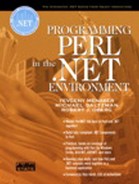Chapter Thirteen. .NET Framework Classes
We have seen how easy it is both to call .NET classes from Perl and to create .NET classes using PerlNET. In this chapter we study a few of the many .NET classes that are available to the PerlNET programmer. These classes should be viewed only as an appetizer to a very rich feast, as the .NET Framework class library has over 2,500 useful classes, which are now available to you as a Perl programmer, thanks to PerlNET. In later chapters we'll look at classes to help you create user interfaces, access databases, and create Web applications. In addition to learning about some useful classes, we will gain further insight into the structure of the .NET Framework and explore some new concepts, such as delegates.
We begin with an examination of the root class Object. This class itself does not provide a lot of functionality, but it defines some virtual methods that are sometimes important for you to override in your own classes. We continue the chapter with a discussion of the important concept of memory management, and we will see some important interactions between the Perl runtime environment and the .NET Common Language Runtime. The CLR provides a powerful garbage collection mechanism, which simplifies memory management in .NET programs.
We then study .NET classes for programming with directories and files. Next, we examine programming with multiple threads. The .NET Framework provides a clean threading model based on delegates, which we will see again in Chapter 14 when we deal with events in user interface applications.
